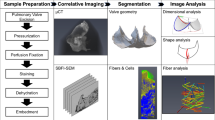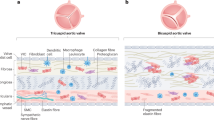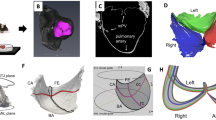Abstract
THE genesis of rheumatic valvular disease in man has been difficult to establish owing to the scarcity of human material in the early stages and the absence of any comparable condition in experimental animals. On the evidence at present available it has been stated that the calcific lesions found in human rheumatic valvular disease are unlikely to be the direct result of the rheumatic process in the valve cusps1. In recent experiments we have been studying the effects of papillary muscle damage and inactivation on the function of the mitral valve and the left ventricle of the dog2. In these experiments either the anterior or the posterior papillary muscle was injected with 0.5–1.0 ml. ethanol and the animal allowed to recover. A surprising finding was that when the animals were killed three months later, four out of twelve dogs in addition to papillary muscle damage also had fibrotic, calcific or chondrific lesions of the mitral valve cusps (Fig. 1). In all four animals the valvular lesion was in the segment of the aortic cusp of the mitral valve which was attached to the damaged papillary muscle and there was no continuity of the valvular lesions with either the papillary muscle lesion through the chordae tendinae or the atriotomy scar in the three animals in which this had been carried out. In ten dogs used as controls in which the ethanol injection was made into the lateral wall of the left ventricle between the papillary muscles, no valvular lesions were found. Histological examination of the lesions showed a fibrous plaque on the atrial surface of the valve cusp with replacement by calcification and chondrification (Fig. 2). There was no evidence of an infective lesion.
This is a preview of subscription content, access via your institution
Access options
Subscribe to this journal
Receive 51 print issues and online access
$199.00 per year
only $3.90 per issue
Buy this article
- Purchase on SpringerLink
- Instant access to full article PDF
Prices may be subject to local taxes which are calculated during checkout
Similar content being viewed by others
References
Edwards, J., in Atlas of Acquired Diseases of the Heart and Great Vessels, 1 (W. B. Saunders, New York, 1961).
Hider, C. F., Taylor, D. E. M., and Wade, J. D., Quart J. Exp. Physiol., 50, 15 (1965).
Croxatto, O. C., Medicina B. Aires, ii, 98 (1953).
Rodbard, S. R., Fed. Proc., 17, 134 (1958).
McCandless, E. C., Lehoczky, I. M., and Rodbard, S., Arch. Path. (Lab. Med.), 75, 507 (1963).
Rodbard, S., Kiwilita, Y., and Martin, M., Science, 143, 1341 (1964).
Logan, A., Wade, J. D., and Taylor, D. E. M., Brit. Heart. J., 26, 704 (1964).
Author information
Authors and Affiliations
Rights and permissions
About this article
Cite this article
TAYLOR, D., WADE, J. & HIDER, C. Heart Valve Lesions following Papillary Muscle Damage. Nature 207, 530 (1965). https://doi.org/10.1038/207530a0
Published:
Issue date:
DOI: https://doi.org/10.1038/207530a0



